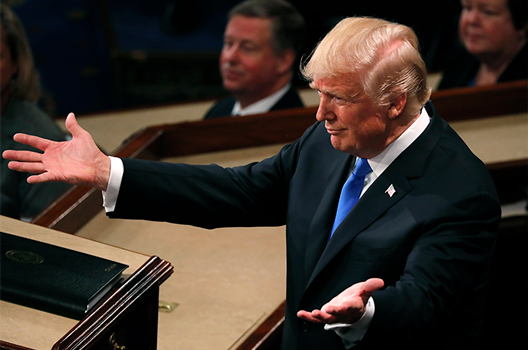 Though hailed as one of US President Donald J. Trump’s key considerations in his 2018 State of the Union address, the topic of infrastructure was handled summarily in a few simple sentences that were short on substance. While there was not much to disagree with in his mention of a perennial problem plaguing and permeating the US policy landscape, there was not much there to work with either.
Though hailed as one of US President Donald J. Trump’s key considerations in his 2018 State of the Union address, the topic of infrastructure was handled summarily in a few simple sentences that were short on substance. While there was not much to disagree with in his mention of a perennial problem plaguing and permeating the US policy landscape, there was not much there to work with either.
In his speech on January 30, Trump said: “As we rebuild our industries, it is also time to rebuild our crumbling infrastructure… Tonight, I am calling on the Congress to produce a bill that generates at least $1.5 trillion for the new infrastructure investment we need.”
This provides only the broadest outlines of a plan. Essentially, Trump’s mention did the following:
- Identified the issue: Crumbling infrastructure.
- Framed a rule: The United States was able to create infrastructure more effectively in the past. For example, he said, the Empire State Building was built in a year. Now, a simple road can take ten years just to permit.
- Offered analysis: Trump said Congress should enact a bill that generates at least $1.5 trillion to invest in gleaming new roads, bridges, highways, railways, and waterways and streamlines the permitting and approval process to two years or less.
- Came to a conclusion: He called for both parties tocome together to give the United States safe, fast, reliable, and modern infrastructure.
Who would disagree with that? However, it is not that simple.
For a decade or more, captains of industry and government leaders have decried the decrepit state of US infrastructure. They encourage investment to catch up on deferred maintenance and make needed advancements and modernization. The American Society of Civil Engineers gave US infrastructure a D+ grade as of 2017. By their estimate, the system requires a $4.59 trillion investment over the next ten years to improve. Similarly, the American Road and Transportation Builders Association recently reported that 54,259 out of a total 612,677 bridges in the United States are structurally deficient, with one out of three bridges needing repair. However, while the problems are many—and known—funding solutions are difficult and hard to come by.
With these statistics in mind, it seems the issue is less about what Trump said, but more about what he did not say in the State of the Union. Several key details did not make the speech, but merit consideration.
How do we pay for that needed infrastructure investment? Which infrastructure needs should be a top priority? What about other infrastructure needs that went unmentioned, such as energy infrastructure? For these areas about which the speech was silent, there is little to go on.
Draft administration infrastructure plans leaked to the media presage a potential overemphasis on rural infrastructure that could give rise to “bridges to nowhere.” On the matter of backbone energy infrastructure needs, namely improving electric transmission and pipelines, the speech remained silent. Finding substance would require reading between the lines about streamlining the permitting and approval process—an idea many presidents have advocated and advanced. While there has been a measure of success, the issue remains a priority.
Perhaps most importantly, on the trillion-dollar question of how to pay for the infrastructure investment, mum was the word. Neither taxes nor tolls made the script. In the past, the Trump administration has suggested that infrastructure investment should be $1 trillion, with only $200 billion coming from federal coffers. It remains unclear how those earlier pronouncements fit with the $1.5 trillion plan suggested in the State of the Union address.
While Trump stated that every federal dollar should be leveraged by partnering with state and local governments, no detail was given on how much leverage there should be or how government financiers would pay for their piece of the trillion-dollar pie. Furthermore, state and local governments are handicapped in funding their piece because of new limits on state and local tax deductibility under the new tax law. As for the federal component, the $1.5 trillion hole already dug by the passage of the recent tax law does not leave many palatable funding options.
In the past, private-public partnerships have often been touted as the solution to funding infrastructure costs. When discussing privatizing public infrastructure or creating private-public partnerships, Trump was careful, advocating tapping into private sector investments only to the extent they are “appropriate.” Notably, there was no mention of the real elephant in the room when it comes to transportation infrastructure—the gas tax, which has not been raised in twenty-five years. Though the US Chamber of Commerce has advocated for such an increase, it was not set forth as a viable source to replenish the Highway Trust Fund. Nor was there mention of reversing the end to transportation earmarks, though in the weeks leading up to the speech there were whispers in the media that such a change in direction might be necessary to sweeten the deal.
In sum, Trump’s State of the Union provided little clarity on how to pay for not simply desirable, but necessary infrastructure solutions.
Cynthia L. Quarterman is a distinguished senior fellow with the Atlantic Council’s Global Energy Center. She formerly served as the administrator of the US Department of Transportation’s Pipeline and Hazardous Materials Safety Administration and the director of the Minerals Management Service.
Image: US President Donald Trump gestures as he delivers his State of the Union address to a joint session of the US Congress on Capitol Hill in Washington, US. January 30, 2018. (REUTERS/Jonathan Ernst)

